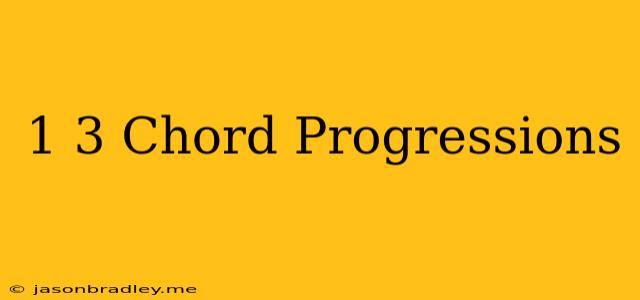The Power of Three: Unlocking the 1-3-4 Chord Progression
The 1-3-4 chord progression is a staple in music, appearing in countless genres from pop and rock to blues and jazz. Its simplicity and versatility make it a favorite among musicians of all skill levels. This progression is a fundamental building block for songwriting, providing a strong foundation for melodies and harmonies.
Understanding the Basics
The 1-3-4 chord progression, as its name suggests, consists of three chords built from the first, third, and fourth degrees of a major scale.
- The I chord (root chord) is the foundation of the progression. It provides a sense of stability and resolution.
- The III chord adds a feeling of tension and anticipation. It creates a natural movement towards the final chord.
- The IV chord resolves the tension created by the III chord and returns the progression to a sense of stability.
Examples of 1-3-4 Progressions
Let's explore some popular examples of the 1-3-4 chord progression in different keys:
Key of C Major:
- C Major (I) - E Major (III) - F Major (IV)
Key of G Major:
- G Major (I) - B Major (III) - C Major (IV)
Key of A Minor:
- A Minor (I) - C Major (III) - D Major (IV)
Why is it So Popular?
- Simplicity: The 1-3-4 progression is easy to remember and play, making it a great choice for beginners.
- Versatility: It can be used in a wide range of genres and moods.
- Emotional Impact: The progression creates a sense of movement and resolution, evoking a range of emotions from joy and anticipation to sadness and reflection.
- Melody Friendly: The progression provides a strong foundation for melodies, naturally guiding the listener's ear.
Beyond the Basics
While the basic 1-3-4 progression is a powerful tool, there are many ways to add variation and complexity.
- Inversions: Experiment with different inversions of the chords to create interesting harmonic movement.
- Substitutions: Use substitute chords (like the ii chord for the IV chord) to add color and complexity.
- Rhythm & Timing: Play with different rhythms and tempos to create a unique feel.
- Extended Chords: Introduce seventh chords or other extensions to add richness and depth.
